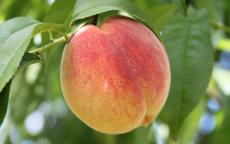Peach trees
Peaches are not quite as easy to grow as apples or plums, but the flavor of home-grown peaches can make it worthwhile trying.
Carolina Belle
Carolina Belle is a large self-fertile white-fleshed freestone peach.- Self-fertility: Self-fertile
- Flesh colour: White
Carolina Gold
A self-fertile cold-hardy late-blooming yellow-flesh freestone peach.- Self-fertility: Self-fertile
- Flesh colour: Golden / Yellow
China Pearl
China Pearl is a cold-hardy late-blooming white-fleshed freestone peach with good fruit size.- Self-fertility: Self-fertile
Contender
A reliable late-blooming yellow-fleshed peach with a good flavor.- Self-fertility: Self-fertile
- Flesh colour: Golden / Yellow
Coralstar®
Coralstar is a yellow-flesh mid-season freestone peach, well-suited to backyard growers.- Self-fertility: Self-fertile
- Flesh colour: Golden / Yellow
Desiree®
Desiree is a self-fertile early-season yellow-fleshed peach.- Self-fertility: Self-fertile
- Flesh colour: Golden / Yellow
Galactica
Galactica is a self-fertile cold-hardy white-fleshed donut or peento peach.- Self-fertility: Self-fertile
- Flesh colour: White
Intrepid
A cold-hardy orange-flesh freestone peach which blooms late in the spring.- Self-fertility: Self-fertile
- Flesh colour: Golden / Yellow
PF8 Ball
PF8 Ball is a sweet self-fertile early-season freestone yellow-flesh peach.- Self-fertility: Self-fertile
- Flesh colour: Golden / Yellow
Redhaven
Redhaven is the definitive American peach - sweet, juicy, with a yellow flesh which comes away easily from the stone.- Self-fertility: Self-fertile
- Flesh colour: Golden / Yellow
How to choose Peach trees
Peaches are a luxurious fruit originating in the Far East and now grown throughout warm temperate regions. Peach trees prefer a continental climate, especially warm or hot summers.
Whilst it is generally advisable to keep pruning of all stone fruit to a minimum, and if possible only prune in early spring, nevertheless regular pruning is quite important with peaches. The main objective is to remove older wood and leave younger shoots - this is because peaches (and nectarines) fruit primarily on 1-year shoots (i.e. the shoots which grew the previous summer).
If your peach tree sets a good crop in the spring then it is important to thin the fruitlets, otherwise you will end up with lots of small peaches with little flavour. Be ruthless with the thinning because the flavor of home-grown peaches eaten straight from the tree is worth a bit of work!

